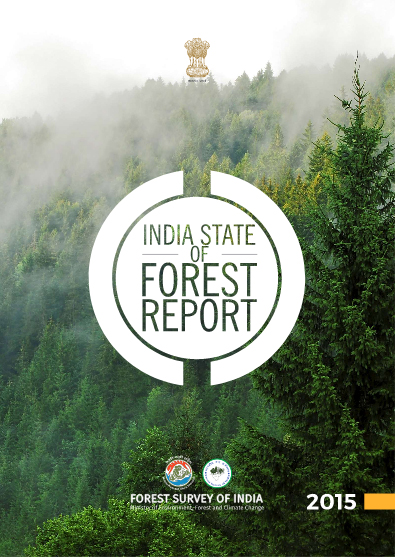FOREST SURVEY REPORT 2021/ A BIENNAL REPORT
India has recorded an increase of 1,540 sq kms in its forest cover, according to the biennial India’s State of Forest Report 2021, published by the Forest Survey of India. This is the increase recorded during 2019 and 2021. The last such report was published in 2019.
The Forest Survey of India defines “forest cover” as all lands of 1 hectare or more with tree patches with canopy density of more than 10 per cent. This covers all lands irrespective of legal ownership and land use.
While “recorded forest area” includes only those areas recorded as forests in government records and include the pristine forests.
India’s total forest cover is 7, 13, 789 square kilometres, or 21.71 per cent of the total geographical area of the country. India has set a target of bringing 33 per cent of its geographical area under forest cover.
But a deep dive into the forest gain according to type of forests brings out the fact that India is not adding dense forests, rather it is losing significant areas of natural forests with moderate tree cover. India has more forest cover with tree canopy density in the range of 10 to 40 per cent, referred to as open forest.
The Forest Survey of India has listed four categories of forests and the state of forest survey is based on these.
They are:
Very Dense Forest (with tree canopy density of 70 per cent or above);
Moderately Dense Forest (tree canopy density of 40 per cent or above but less than 70 per cent);
Open Forests (tree canopy density of 10 per cent or above but less than 40 per cent); and
Scrub (tree canopy density less than 10 per cent).
Open Forest currently has the biggest share in the country’s forest cover with 9.34 per cent of the total forest cover (3, 07, 120 square kilometres).
Very Dense Forests (the pristine natural forests) account for just 3.04 per cent (99, 779 sq kms) of the total forest cover. This is the least share among the three major types of forests, very dense, moderately dense and the open forests.
Moderately dense forests account for 9.33 per cent (3, 07, 120 square kilometres) of total forest cover.
Under the Very Dense Forest category, in the last two years, India has reported an increase of just 501 square kilometres. Under the Moderately Dense Forests category, there is a loss of 1,582 square kilometres. Open Forests have reported an increase of 2, 612 square kilometres.
To the net increase in forest cover of 1,540 square kilometres, five states – Andhra Pradesh, Telangana, Odisha, Karnataka and Jharkhand – have contributed almost entirely. According to India's State of Forest 2021, this increase is also due to plantation and agroforestry.
While 11 states have reported loss in forest cover, some 21 states and UTs have reported loss in moderately dense forest cover.
Currently, Madhya Pradesh has the largest forest cover in the country while the northeastern states have the highest percentage of forest cover.
Nearly half of India’s forest and tree cover (315,667 square kilometres, or 45 per cent) can emerge as ‘climate hotspots’ — areas expected to be affected by climate change — the Forest Survey of India (FSI) warned in its latest assessment.
By 2030, 315,667 square kilometres (sq km) or 45 per cent of India’s forest and tree cover are set to emerge as ‘climate hotspots’.
Climate hotspot is an area expected to be adversely impacted by climate change, the Forest Survey of India (FSI) said in its latest assessment on forests for 2021 released January 13, 2022.
By 2050, 448,367 sq km or 64 per cent of India’s forest and tree cover is likely to face the ‘high severity’ of climate change, the report titled State of India’s Forests Report, 2021 (SoFR, 2021), said.
High severity means that India’s green cover is expected to see a rise in temperature between the range of 1.5 and 2.1 degrees Celsius. Climate change hotspots will also see a change in rainfall patterns with an increase or decrease of 20-26 per cent, the SoFR, 2021, said.
These projections are based on the collaborative study between FSI and the BITS, Pilani (Goa Campus) to map climate hotspots in the forest areas of the country.
The study made use of the computer model-based projections of temperature and rainfall in three ‘time horizons’ — 2030, 2050 and 2085.
Over 55 per cent of India’s tropical dry deciduous forests, the top most dominant type of forests, will be severely affected by climate change.
Of 313,617 sq km, 172,719 sq km will be highly vulnerable to climate change. These forests occur in the region with very low rainfall of 100-150 centimetres, with five to six dry months.
Thus, 84 per cent of Chhattisgarh’s forest area is most likely to become a climate hotspot. In Madhya Pradesh, 65 per cent of the area under forests will be vulnerable to climate change impacts.
Tropical moist deciduous forests and tropical semi-evergreen forests, the second and third most prominent type of forests too are highly vulnerable. Some 47 per cent and 40 per cent of the tropical moist deciduous forests and tropical semi-evergreen forests respectively will be affected by climate change.
The entire area under the top three dominating forest types covering a total of 520,280 sq km will fall under climate change hotspots from 2050 onwards.
Hence, forests in large parts of Madhya Pradesh, Chhattisgarh, the northern part of Odisha and western part of Jharkhand will be impacted by adverse impacts of climate change from 2050 onwards, the biennial forests report said.
| Forest type | Total area (in sq km, in 2019) | Area falling within climate hotspot in 2030 (in %) | Area falling within climate hotspot in 2050 (in %) | Area falling within climate hotspot in 2085 (in %) |
| Tropical wet evergreen forest | 20,054 | 22.18 | 81.49 | 98.32 |
| Tropical semi-evergreen forest | 71,171 | 40.07 | 100.00 | 100.00 |
| Tropical moist deciduous forest | 135,492 | 47.19 | 100.00 | 100.00 |
| Littoral and swamp forest | 5,596 | 9.69 | 68.05 | 100.00 |
| Tropical dry deciduous forest | 313,617 | 55.07 | 100.00 | 100.00 |
| Tropical thorn forest | 20,877 | 46.64 | 76.74 | 76.76 |
| Tropical dry evergreen forest | 937 | 0.64 | 95.62 | 95.62 |
| Sub-tropical broad leaved hill forest | 32,706 | 15.09 | 64.56 | 64.56 |
| Sub-tropical pine forest | 18,102 | 93.66 | 99.76 | 99.99 |
| Sub-tropical dry evergreen forest | 180 | 100.00 | 100.00 | 100.00 |
| Montane wet temperate forest | 20,435 | 5.08 | 26.10 | 26.10 |
| Himalayan moist temperate forest | 25,743 | 100.00 | 100.00 | 100.00 |
| Himalayan dry temperate forest | 5,627 | 100.00 | 100.00 | 100.00 |
| Sub-alpine forest | 14,995 | 99.14 | 100.00 | 100.00 |
| Moist alpine scrub | 959 | 100.00 | 100.00 | 100.00 |
| Dry alpine scrub | 29,22 | 100.00 | 100.00 | 100.00 |
Source: State of India’s Forests Report, 2021
The results of the climate change hotspot study presented for the first time in the report is relevant for state forest departments in designing mitigation and adaptation programmes for forest areas under their management.
“This serves as the baseline for state governments to incorporate climate change in their land and development policies,” Chandra Prakash Goyal, director-general of forests, Union environment ministry, said in his foreword.


.jpg)








0 Comments